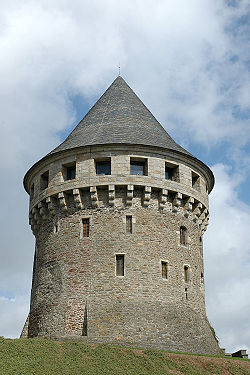
Tour Tanguy
Encyclopedia

Motte-and-bailey
A motte-and-bailey is a form of castle, with a wooden or stone keep situated on a raised earthwork called a motte, accompanied by an enclosed courtyard, or bailey, surrounded by a protective ditch and palisade...
beside the Penfeld
Penfeld
The Penfeld, Penfell in Breton, is a 16 km-long French coastal river. On its left bank has grown up the town of Brest in Finistère.-Course:...
river in Brest, France
Brest, France
Brest is a city in the Finistère department in Brittany in northwestern France. Located in a sheltered position not far from the western tip of the Breton peninsula, and the western extremity of metropolitan France, Brest is an important harbour and the second French military port after Toulon...
. Probably built during the Breton War of Succession
Breton War of Succession
The Breton War of Succession was a conflict between the Houses of Blois and Montfort for control of the Duchy of Brittany. It was fought between 1341 and 1364. It formed an integral part of the early Hundred Years War due to the involvement of the French and English governments in the conflict; the...
, it faces the château de Brest
Château de Brest
The Château de Brest is a castle in Brest, Finistère, France. The oldest monument in the town, it is located at the mouth of the river Penfeld at the heart of the roadstead of Brest, one of the largest roadsteads in the world...
and is now accessed by a road off the square Pierre Péron, at one end of the pont de Recouvrance
Pont de Recouvrance
The pont de Recouvrance is a vertical-lift bridge in Brest, France, across the river Penfeld. Opened on 17 July 1954, it was the largest vertical-lift bridge in Europe until the opening of the Pont Gustave-Flaubert in 2008...
. It now houses the Museum of Old Brest, a museum with a collection of diorama
Diorama
The word diorama can either refer to a nineteenth century mobile theatre device, or, in modern usage, a three-dimensional full-size or miniature model, sometimes enclosed in a glass showcase for a museum...
s that depict the city of Brest on the eve of World War II.
History
Probably built to protect or block crossings between the two banks of the river, the tower's origins cannot be precisely determined. It may have been built by the English during their occupation of the city in the 14th century, or earlier by lord Tanguy du Chastel, of the line of lords of Quilbignon which distinguished itself in battles against the English in Brittany and contributed to the development of the right bank. The name bastille de Quilbignon gives places to that of tour Tanguy, a forename held by members of this line. Their arms are engraved below the tower's gate. The family's powerbase was at the château de Trémazan at LandunvezLandunvez
Landunvez is a commune in the Finistère department of Brittany in north-western France.-Population:Inhabitants of Landunvez are called in French Landunvéziens.-References:** ;-External links:* *...
.
Jean de Montfort
John IV, Duke of Brittany
John IV of Montfort , was duke of Brittany, from 1341 to his death. He was son of Duke Arthur II and Yolande de Dreux, countess of Montfort, his second wife.In 1322 he succeeded his mother as count of Montfort, and in 1329, he married Joanna of Flanders at Chartres...
handed it over to the English in 1341, but it was restored to his son John V, Duke of Brittany
John V, Duke of Brittany
John V the Conqueror KG was Duke of Brittany and Count of Montfort, from 1345 until his death.-Numbering:...
in 1397. Until about 1580, the tower was the seat of justice for the lords of Le Châtel, and it was neglected after that date, becoming the property of the Rohan-Guéméné family in 1786 before becoming a French royal possession and finally being sold to a Mr Gabon on the French Revolution
French Revolution
The French Revolution , sometimes distinguished as the 'Great French Revolution' , was a period of radical social and political upheaval in France and Europe. The absolute monarchy that had ruled France for centuries collapsed in three years...
.
In 1862, it was bought by the architect Barillé who turned it into his house, cutting windows and building on its top a sort of Chinese-style
Chinoiserie
Chinoiserie, a French term, signifying "Chinese-esque", and pronounced ) refers to a recurring theme in European artistic styles since the seventeenth century, which reflect Chinese artistic influences...
roof over a kiosk or pavilion. Its last occupant and private owner, doctor Joseph Thielmans, left it after it caught fire during the bombardment of 1944 (the bombing also destroyed the pavilion). It was acquired by the town of Brest on 15 July 1954 and summarily repaired, but its state worsened once more and its future was compromised by the redevelopment of the Recouvrance
Recouvrance, Brest
Recouvrance is the section of the city of Brest, France which lies on the right bank of the river Penfeld. It is a popularly and historically Breton quarter, in contrast to the largely Francophone quarter of Brest-même or Brest-proper on the left bank....
quarter. In 1959 the town finally charged the painter Jim E. Sévellec with evoking the town's past, of which few remains were left. The tower was restored and opened as the Museum of Old Brest on 25 July 1962. In 1971, a turret was added and the Neo Gothic cornice along the battlements replaced to restore the tower to its medieval shape.
2nd floor

External links
- http://www.mairie-brest.fr/sillage/sillage_70.pdf

